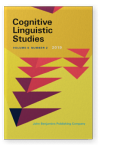An algebraic perspective on abstract and concrete domains
Looking at isomorphic constructs from an algebraic perspective, this article suggests that every concrete
construct is understood by reference to an underlying abstract schema in the mind of comprehender. The complex form of every
abstract schema is created by the gradual development of its elementary form. Throughout the process of cognitive development, new
features are added to the elementary form of abstract schema, which leads to gradual formation of a fully-developed abstract
schema. Every developed abstract schema is the underlying source for understanding an infinite number of concrete isomorphic
constructs. It is suggested that the process of the mapping of base domain (base construct) unto target domain (target construct)
is conducted and mediated by an abstract domain. This abstract domain, which is free from concrete features of base and target, is
isomorphic to both base and target domains. To describe the mediatory role of this abstract domain, it might be argued that the
chain process of understanding a less familiar domain in terms of a relatively more familiar domain (salience imbalance model)
cannot continue infinitely. This chain must stop at some point. This point is the abstract domain, which is isomorphic to base and
target domains.
Article outline
- 1.Introduction
- 2.Isomorphic constructs
- 3.Isomorphic constructs in mathematics
- 4.Concrete and abstract domains
- 5.Conceptual metaphor theory and chain of domains
- 6.Concrete realization of abstract domains
- 7.Pairs of domains throughout the chains
- 8.Conclusion
- Acknowledgements
- Note
-
References
References
Bowdle, B. F., & Gentner, D.
(
1999)
Metaphor comprehension: From comparison to Categorization. In
M. Hahn &
S. C. Stoness (Eds.),
Proceedings of twenty-first annual conference of cognitive science society (pp. 90–95). Mahwah, NJ: LEA.

Falkenhainer, B., Forbus, K. D., & Gentner, D.
(
1989)
The structure-mapping engine: Algorithm and examples.
Artificial Intelligence, 411, 1–63.


Fraleigh, J. B.
(
2003)
A First Course in Abstract Algebra (7th edition).

Gentner, D.
(
1983)
Structure-mapping: a theoretical framework for analogy.
Cognitive Science, 71, 155–170.


Gibbs, R. W.
(
2011)
Evaluating conceptual metaphor theory.
Discourse Process, 48(8), 529–562.


Indurkhya, B.
(
1987)
Approximate semantic transference: A computational theory of metaphor and analogy.
Cognitive Science, 111, 445–480.


Judson, T. W.
(
2012)
Abstract Algebra.
[URL]
Khatin-Zadeh, O., & Vahdat, S.
Khatin-Zadeh, O., Vahdat, S., & Yazdani-Fazlabadi, B.
Kitty, E. F., & Lehrer, A.
Lakoff, G., & Johnson, M.
(
1980)
Metaphors we live by. Chicago: University of Chicago Press.

Lakoff, G., & Johnson, M.
(
2003)
Metaphors We Live By. London: The University of Chicago Press.


Moss, H. E., Tyler, L. K., & Taylor, K. I.
(
2007)
Conceptual structure. In
G. Gaskell (Ed.),
Oxford handbook of psycholinguistics (pp. 217–234). Oxford, UK: Oxford University Press.

Ortony, A.
(
1979)
Metaphor, language, and thought. In
A. Ortony (Ed.),
Metaphor and thought (pp. 1–19). Cambridge: Cambridge University Press.

Ortony, A., Vondruska, R. J., Foss, M. A., & Jones, L. E.
(
1985)
Salience, similes, and the asymmetry of similarity.
Journal of Memory and Language, 241, 569–594.


Taylor, K. I., Devereux, B. J., & Tyler, L. K.
(
2011)
Conceptual structure: Towards an integrated neurocognitive account.
Language and Cognitive processes, 26(9), 1368–1401.


Tyler, L. K., & Moss, H. E.
(
2001)
Towards a distributed account of conceptual knowledge.
Trends in Cognitive Sciences, 51, 244–252.


Verbrugge, R. R., & McCarrell, N. S.
(
1977)
Metaphoric comprehension: studies in reminding and resembling.
Cognitive Psychology, 91, 494–533.


Vigliocco, G., Vinson, D., Lewis, W., & Garrett, M.
(
2004)
Representing the meanings of object and action words: The featural and unitary semantic space hypothesis.
Cognitive Psychology, 48 (4), 422–488.


Cited by
Cited by 1 other publications
Khatin-Zadeh, Omid & Hooshang Khoshsima
2021.
Homo-schematic Metaphors: A Study of Metaphor Comprehension in Three Different Priming Conditions.
Journal of Psycholinguistic Research 50:4
► pp. 923 ff.

This list is based on CrossRef data as of 22 october 2022. Please note that it may not be complete. Sources presented here have been supplied by the respective publishers.
Any errors therein should be reported to them.
